Related Research Articles

Erythrose is a tetrose saccharide with the chemical formula C4H8O4. It has one aldehyde group, and is thus part of the aldose family. The natural isomer is D-erythrose; it is a diastereomer of D-threose.

The Burkholderiales are an order of Pseudomonadota. Like all Pseudomonadota, they are Gram-negative. They include several pathogenic bacteria, including species of Burkholderia, Bordetella, and Ralstonia. They also include Oxalobacter and related genera, which are unusual in using oxalic acid as their source of carbon. Other well-studied genera include Alcaligenes, Cupriavidus, Achromobacter, Comamonas, Delftia, Massilia, Duganella, Janthinobacterium, Polynucleobacter, non-pathogenic Paraburkholderia, Caballeronia, Polaromonas, Thiomonas, Collimonas, Hydrogenophaga, Sphaerotilus, Variovorax, Acidovorax, Rubrivivax and Rhodoferax, and Herbaspirillum.

The Comamonadaceae are a family of the Betaproteobacteria. Like all Pseudomonadota, they are Gram-negative. They are aerobic and most of the species are motile via flagella. The cells are curved rod-shaped.

Alcaligenes faecalis is a species of Gram-negative, rod-shaped bacteria commonly found in the environment. It was originally named for its first discovery in feces, but was later found to be common in soil, water, and environments in association with humans. While opportunistic infections do occur, the bacterium is generally considered nonpathogenic. When an opportunistic infection does occur, it is usually observed in the form of a urinary tract infection.

Alcaligenes is a genus of Gram-negative, aerobic, rod-shaped bacteria. The species are motile with amphitrichous flagella and rarely nonmotile. It is a genus of non-fermenting bacteria. Additionally, some strains of Alcaligenes are capable of anaerobic respiration, but they must be in the presence of nitrate or nitrite; otherwise, their metabolism is respiratory and never fermentative; The genus does not use carbohydrates. Strains of Alcaligenes are found mostly in the intestinal tracts of vertebrates, decaying materials, dairy products, water, and soil; they can be isolated from human respiratory and gastrointestinal tracts and wounds in hospitalized patients with compromised immune systems. They are occasionally the cause of opportunistic infections, including nosocomial sepsis.
Pseudomonas alcaligenes is a Gram-negative aerobic bacterium used for bioremediation purposes of oil pollution, pesticide substances, and certain chemical substances, as it can degrade polycyclic aromatic hydrocarbons. It can be a human pathogen, but occurrences are very rare. Based on 16S rRNA analysis, P. alcaligenes has been placed in the P. aeruginosa group.

Arylsulfatase (EC 3.1.6.1, sulfatase, nitrocatechol sulfatase, phenolsulfatase, phenylsulfatase, p-nitrophenyl sulfatase, arylsulfohydrolase, 4-methylumbelliferyl sulfatase, estrogen sulfatase) is a type of sulfatase enzyme with systematic name aryl-sulfate sulfohydrolase. This enzyme catalyses the following chemical reaction

Food microbiology is the study of the microorganisms that inhabit, create, or contaminate food. This includes the study of microorganisms causing food spoilage; pathogens that may cause disease ; microbes used to produce fermented foods such as cheese, yogurt, bread, beer, and wine; and microbes with other useful roles, such as producing probiotics.

Cupriavidus necator is a Gram-negative soil bacterium of the class Betaproteobacteria.
Biosurfactant usually refers to surfactants of microbial origin. Most of the biosurfactants produced by microbes are synthesized extracellularly and many microbes are known to produce biosurfactants in large relative quantities. Some are of commercial interest.

Extracellular polymeric substances (EPSs) are natural polymers of high molecular weight secreted by microorganisms into their environment. EPSs establish the functional and structural integrity of biofilms, and are considered the fundamental component that determines the physicochemical properties of a biofilm.
Arsenate reductase (azurin) (EC 1.20.9.1) is an enzyme that catalyzes the chemical reaction

In enzymology, a maleate isomerase, or maleate cis-tran isomerase, is a member of the Asp/Glu racemase superfamily discovered in bacteria. It is responsible for catalyzing cis-trans isomerization of the C2-C3 double bond in maleate to produce fumarate, which is a critical intermediate in citric acid cycle. The presence of an exogenous mercaptan is required for catalysis to happen.
Poly(3-hydroxybutyrate) depolymerase is an enzyme used in the degradation processes of a natural polyester Poly(3-hydroxyburate). This enzyme has growing commercialization interests due to it implications in biodegradable plastic decomposition.
Cupriavidus metallidurans is a non-spore-forming, Gram-negative bacterium which is adapted to survive several forms of heavy metal stress.

The PlayStation 4 (PS4) is a home video game console developed by Sony Computer Entertainment. Announced as the successor to the PlayStation 3 in February 2013, it was launched on November 15, 2013, in North America, November 29, 2013 in Europe, South America and Australia, and on February 22, 2014 in Japan. A console of the eighth generation, it competes with Microsoft's Xbox One and Nintendo's Wii U and Switch.
Alcaligenes aaquatilis is a Gram-negative, catalase- and cytochrome oxidase-positive, motile bacterium with peritrichous flagella, from the genus Alcaligenes, which was isolated in Germany from sediments of the Weser Estuary and in Shem Creek in Charleston Harbor in the United States from a salt marsh. A complete genome sequence of A. aquatilis is publicly available in DNA Data Bank of Japan, European Nucleotide Archive, and GenBank.
Alcaligenes cupidus is a bacterium from the genus Alcaligenes which was isolated from seawater.
Alcaligenes denitrificans is a Gram-negative, oxidase- and catalase-positive, strictly aerobic, motile bacterium with peritrichous flagella, from the genus Alcaligenes. Based on 16S rDNA sequence analysis and the low degree of DNA relatedness between other members of Achromobacter species, Yabuuchi et al propose that Alcaligenes denitrificans should be classified as a subspecies of Achromobacter xylosoxidans.
Azohydromonas lata is a gram-negative, hydrogen-using bacterium from the genus Azohydromonas. Alcaligenes latus has been reclassified as Azohydromonas lata.
References
- ↑ "Alcaligenes viscolactis" at http://www.usu.edu/westcent/microstructure_food/Alcalige.htm Retrieved 9 September 2015
- ↑ Snopes.com: "Steep risk." Retrieved 9 September 2015